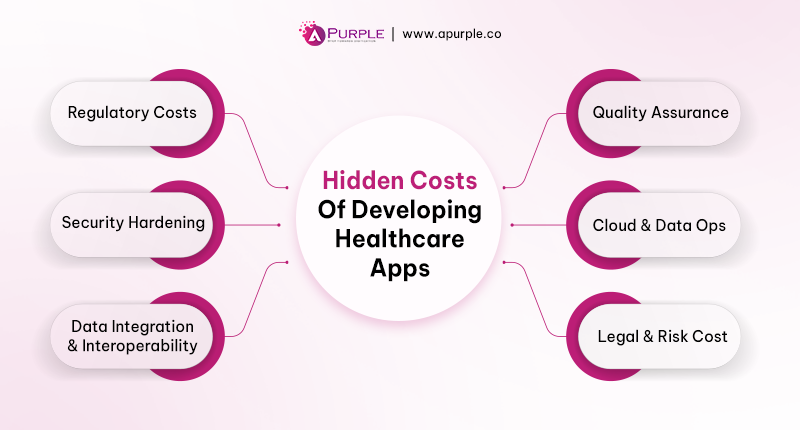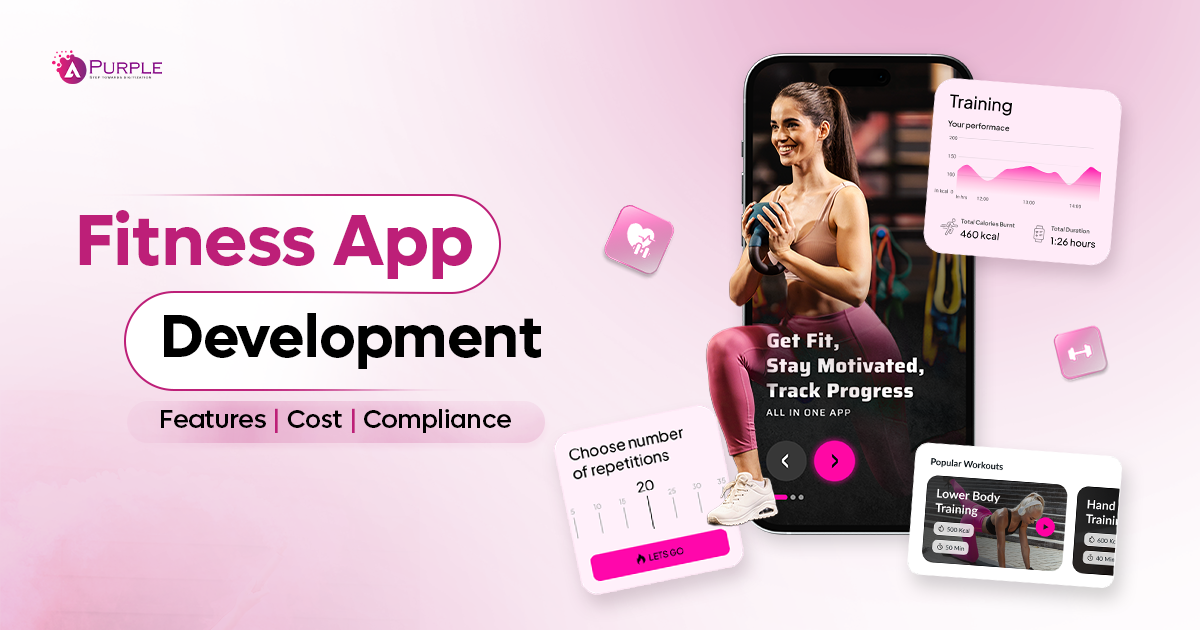
Planning to build a healthcare app but unsure of the costs?
Whether you’re launching a telehealth platform, a chronic care solution, or a patient-facing wellness app, development costs can range from USD 12,000 to USD 100,000+.
However, a startup owner, entrepreneur, or founder needs to understand that all of the above apps can have different costs. Healthcare app development costs can vary based on the type, feature complexity, compliance requirements, platform strategy, and post-launch needs of your application.
To get a complete picture, you need,
- Breakdown of the cost to develop a healthcare app
- Factors and their impact on the cost of healthcare app development
- Hidden costs and red flags
- Strategies that you can use to reduce the cost.
In this guide, you will find all of the above, plus cost categorization by product type and comprehensive costs for healthcare app development. However, first, here is a breakdown of the healthcare app development cost.
How Much Does It Cost to Develop a Healthcare App?
The cost of healthcare app development depends on several factors, including features, app type, regulatory requirements, and the chosen development platform.
Here is a breakdown of healthcare app development costs, categorized by the level of app complexity.
| App Type | Estimated Cost Range (USD) | Typical Features |
|---|---|---|
| Basic MVP Healthcare App | $12,000–$24,000+ | Appointment scheduling, medication reminders, basic health tracking |
| Mid-Range Healthcare App | $24,000–$36,000+ | Telemedicine (video calls, chat), EHR integration, health device connections |
| Advanced Healthcare App | $36,000–$80,000+ | AI-driven analytics, real-time health data, multi-platform, high compliance |
As a startup owner, the above breakdown may seem overwhelming, but there are many additional factors to consider. To simplify the cost estimation of healthcare app development, consider the following formula.
So, here is the formula,
- D = estimated development hours for all planned features.
- Q = quality-assurance hours (commonly 20–25% of D).
- R = blended hourly rate for engineers, designers, and PMs.
-
P = platform multiplier
- 1 × for single platform (iOS, Android, or web)
- 1.6 × for two platforms
- 2.1 × for three (iOS + Android + web)
- C = regulatory-compliance premium (HIPAA, GDPR, HL7/FHIR), typically 8–15% of (D × R).
- S = post-launch support & maintenance, often budgeted at 15–20% of the initial build per year.
As you can observe, the formula encompasses multiple elements, including development hours, features, QA, platforms, regulatory compliance, and post-launch and support activities.
So, if you are wondering how much a healthcare app development costs, the first key factor you need to analyze is “app type.”
What Is The Healthcare App Development Cost Based On App Type?
Understanding the cost hinges on the healthcare app idea you plan to build and the complexity of the features required. App type directly shapes not only the investment but also the project timeline and ROI opportunities.
Key Healthcare App Type You Must Consider
- Telemedicine/Telehealth Apps: Require features like secure video calls, patient record storage, appointment scheduling, and compliance with healthcare regulations.
- Wellness & Fitness Apps: When creating a fitness app, prioritize effective tracking, gamification, and seamless integrations with wearable devices.
- Chronic Disease Management Apps: Need robust patient tracking, real-time alerts, and data analytics.
- Appointment Scheduling Apps: Simpler systems that manage calendars, reminders, and notifications.
- Electronic Medical Records (EMR/EHR) Apps: Requires complex database architecture, compliance (such as HIPAA), and seamless workflows.
Here is a comparison of healthcare app development costs based on the type of applications you can develop.
| App Type | Cost Range | Development Time | Key ROI Levers | Best For |
|---|---|---|---|---|
| Telemedicine | $24,000 – $36,000+ | 12–24 weeks | Recurring consultations, EHR integration | Clinics, telehealth startups |
| Fitness & Wellness | $24,000 – $36,000+ | 8–20 weeks | Subscription, partnerships, wearables | Lifestyle brands, wellness co-ops |
| Chronic Disease Management | $25,000 – $500,000 | 24–40 weeks | Patient retention, payer partnerships | Pharma, specialty care providers |
| Appointment Scheduling | $12,000 – $20,000 | 6–12 weeks | Reduced admin costs and patient satisfaction | Small practices, service providers |
| Health Records/EMR | $12,000 – $20,000 | 12–24 weeks | Workflow efficiency, data monetization | Hospitals, large clinics |
Now that you know the type of application affects the healthcare app development cost, let’s discuss different factors that impact the price.
What Are The Key Factors That Affect Healthcare App Development Cost?
Building a healthcare app is an investment shaped by numerous factors. A clear understanding of these factors will help you optimize both budget and project outcomes.
Here are the key factors that impact the cost of healthcare app development.
1. App Development Time
As per our earlier formula, “D,” or the estimated development time, significantly impacts the total cost of healthcare app development. Estimating the time required for development necessitates consideration of several factors, including app complexity, regulatory requirements, and integration needs.
Here are the timelines for some of the healthcare apps,
- Basic symptom checker app: Typically requires 6–12 weeks, offering faster market entry points with limited features.
- Fitness trackers or basic wellness apps: Best suited for launches in 12–24 weeks, balancing richer features and manageable costs.
- Telemedicine apps: Can extend to 20–40+ weeks, reflecting on the time needed for development, rigorous testing, and multi-party data workflows.
| App type | Indicative MVP cost range (USD) |
|---|---|
| Basic symptom-checker app | $12,000 – $24,000 |
| Fitness-tracker or basic wellness app | $24,000 – $36,000+ |
| Telemedicine app | $24,000 – $36,000+ |
Founder’s Insight:
2. Regulatory Compliance & Data Security
Healthcare apps must comply with standards such as HIPAA and GDPR, as well as other relevant regulations. For example, a hospital with millions of patient records needs a system that ensures data protection. It is essential for both patient trust and compliance.
To comply with such data regulations, you need,
- Robust encryption and access control implementation.
- Regular security audits and vulnerability assessments.
- Thorough documentation and legal consultations.
These compliance requirements add to the cost of developing a healthcare app. The measures you take to secure a healthcare app can increase the cost, including SSL certification expenses and the development of secure systems.
Here is a breakdown of the security costs and their impact on the total cost of healthcare app development.
| Activity | Typical Timeline | % of Initial Build Cost | Cost Range | Reason for Spend |
|---|---|---|---|---|
| Threat modeling & risk assessment | 0.5–1 week | >1% | Included | Identifies exploitable gaps early. |
| Penetration testing (network, API, mobile) | 1–2 weeks | 5–8% | $7,500 – $12,000 | Independent audits safeguard PHI and meet payer requirements. |
| Compliance documentation (HIPAA, GDPR, SOC 2) | 0.5–1 week | 2–4% | $3,000 – $6,000 | Required evidence for app-store review and enterprise deals. |
| Remediation sprints | 0.5–1 week | 1–2% | $1,500 – $3,000 | Resolves critical findings before launch. |
| Total Security & Compliance Investment | 2–4 weeks | 8–12% | $12,000 – $18,000 | Protects against breaches and regulatory fines. |
| Ongoing re-testing & policy updates | Continuous | 5–10% of annual maintenance | $1,500 – $4,500 each year | Maintains certification and payer confidence. |
Founder’s Insight:
3. Platform Choice: Native, Hybrid, or Web
The platform you choose to deploy the app also impacts the cost. Each platform and development approach has a different set of requirements that can alter the expenses.
So, what to choose?
- Native app development– Higher cost, but superior performance.
- Hybrid app development– Faster, cost-effective for MVPs, yet sometimes limited in UX.
- Web app development– Quickest to market, lowest upfront cost, but may restrict functionalities.
| Development approach | Why you’d pick it | MVP Cost Range |
|---|---|---|
| Native (separate iOS & Android) | Best performance, richest device APIs, App-Store polish | $14,000 – $24,000+ |
| Hybrid Apps | One code-base, near-native UX, faster first release | $20,000 – $34,000+ |
| Web / Progressive Web App | Fastest & cheapest path to validate an idea, browser-only | $12,000 – $18,000+ |
Founder’s Insight:
4. Team Expertise
A crucial costing factor when calculating the cost to develop a healthcare app is the expertise and location of your development team. Here, distance matters the most. An onshore team will cost more than a nearshore team. An offshore team costs less than a nearshore team.
Here is a breakdown of the costs based on expertise,
| Outsourcing Model | Typical MVP Timeline | MVP Cost Range |
|---|---|---|
| On-shore teams | 10 – 18 weeks | $20,000 – $90,000 |
| Near-shore teams | 14 – 26 weeks | $12,000 – $50,000 |
| Off-shore teams | 20 – 36 weeks | $15,000 – $35,000 |
Founder’s Insight:
5. Integration & Third-Party Services
Seamlessly connecting your healthcare app with external systems, EHRs, payment gateways, telemedicine SDKs, or wearable devices adds significant value but also complexity.
- EHR/EMR integrations: Add substantial cost and extend timelines by 6–12 weeks, depending on the maturity of the API and the partner’s responsiveness.
- Payment gateways, video SDKs, cloud storage: Each integration introduces licensing fees and requires 2–4 weeks of additional development.
- Wearables/API integrations: Time and cost scale with the diversity and depth of device integration.
| Integration type | MVP extra dev time | MVP cost (USD) |
|---|---|---|
| EHR / EMR (FHIR, HL7, proprietary) | 3-6 weeks | $12,000 – $25,000 |
| Payment gateway (Stripe, Braintree, etc.) | 1-2 weeks | $3,000 -$7,000 |
| Telemedicine/video SDK (Twilio, Agora, Vonage) | 1-2 weeks | $4,000 – $8,000 |
| Cloud storage SDK (AWS S3, GCS, Azure) | 1 week | $2,000 – $35,000 |
| Wearable / device APIs (Apple Health, Fitbit, BLE) | 2-4 weeks/device family | $5,000- $12,000 |
Founder’s Insight:
6. Design & User Experience
Many entrepreneurs think it’s the backend because of the data-intensive nature of such applications. And if you are one of them, then you may be wrong! Because it’s not the backend, it’s the user frontend! An intuitive and interactive app interface makes your healthcare apps easy to use for patients. However, an intuitive and well-designed app can be more expensive.
Here is the breakdown of the healthcare app development cost for the design process.
| Design Deliverable | Typical Timeline | Share of Build Budget | Example Cost |
|---|---|---|---|
| Wireframes & interactive prototypes | 1–2 weeks | 4–6% | $6,000 – $9,000 |
| High-fidelity UI, branding & micro-interactions | 1–2 weeks | 5–7% | $7,500 – $10,500 |
| Accessibility compliance & usability testing (WCAG, seniors, disabilities) | 1–1.5 weeks | +10–15% on top of design subtotal | $3,000 – $4,500 |
| Design hand-off, component library & style guide | 1 week | 2–3% | $3,000 – $4,500 |
| Total design investment | 2–6 weeks | 15–25% | $22,500 – $37,500 |
Founder’s Insight:
7. Post-Launch Enhancements
Once you have developed and tested your healthcare app, your work is not yet complete. As a startup owner seeking to stay competitive, you must ensure your app performs consistently. This adds to the cost of developing a healthcare app.
| Activity | Annual Cost as % of Initial Build | Cost Range | Cost Impact Rationale |
|---|---|---|---|
| Continuous compliance updates | 5–10% | $7,500 – $15,000 | Keeps pace with evolving HIPAA and GDPR, as well as security patches. |
| User feedback-driven iterations | 8–12% | $12,000 – $18,000 | Adds features that boost retention and competitiveness. |
| Bug fixes & performance optimizations | 5–8% | $7,500 – $12,000 | Preserves reliability and clinical trust. |
| Infrastructure scaling & 24/7 support | 5–8% | $7,500 – $12,000 | Ensures uptime, latency, and patient-safety SLAs. |
| Total Annual Maintenance | 20–30% | $30,000 – $45,000 | Ongoing spend is essential for legal compliance, growth, and ROI. |
Founder’s Insight:
Startups that treat post-launch as a growth phase, rather than a cost center, sustain engagement and uncover new revenue streams, which are critical in the crowded, compliance-driven healthcare app market.
Healthcare App Development Cost by Product Type
The cost of healthcare app development also depends on the type of product you are building and for whom you are creating it. For example, the cost of developing apps for doctors differs from that of a healthcare app for hospitals.
Here is a breakdown of healthcare app development costs for different product types.
| Primary User Group | Common Product Types | Cost Range | Key Features That Drive Cost |
|---|---|---|---|
| Clinicians |
|
$15,000- $30,000+ | secure video, e-prescribing, real-time vitals, FHIR/HL7 data sync, audit logging |
| Hospitals & Health Systems |
|
$20,000- $50,000+ | Multi-role dashboards, integration with on-premise EMR/LIS/RIS, role-based access, enterprise SSO, complex analytics |
| Patients & Consumers |
|
$25,000- $35,000+ | Sensor data sync, gamification, medication reminders, secure messaging, accessibility & multilingual UX |
What Distinguishes Each Category?
Understanding how the end-user group influences feature scope and compliance obligations is the most effective way to predict and control healthcare app budgets.
1. Clinician-Facing Apps
- Regulatory depth: Must meet HIPAA, often SOC 2, and sometimes CE-marked clinical risk classifications.
- Workflow complexity: Developing a telemedicine app for clinicians involves complex workflows. It will require real-time data and decision support.
- User interface: Dense information hierarchies are designed to minimize cognitive load during patient care.
2. Hospital & Enterprise Apps
- Integration footprint: Deeply integrates with legacy on-premises systems and medical-device networks, pushing costs to the top of the range.
- Scalability & uptime: Apps must support hundreds of concurrent clinicians with ≥99.9% SLA, demanding robust DevOps and monitoring.
- Governance: Enterprise SSO, role-based permissions, and change-control boards elongate development cycles.
3. Patient-Facing Apps
- Consumer-grade UX: Success hinges on intuitive navigation, motivation loops, and accessibility for seniors and users with disabilities.
- Data sources: Primarily draw from phone sensors, wearables, or lightweight API feeds, keeping backend complexity lower than clinician/hospital apps.
- Compliance scope: Many wellness apps qualify for the HIPAA “low-risk” exemption if they avoid storing identifiable health information, thereby lowering their security spend.
4. Cost Levers to Monitor
- Integration count: Each additional third-party API (EHR, wearable, payment gateway) can add 10 – 15% to the budget.
- Security & Compliance: Allocate 8–12% of the initial cost for penetration testing, HIPAA/GDPR documentation, and remediation.
- Design & accessibility: Expect 15–25% of total spend for rigorous UX/UI WCAG compliance, which adds another ~15% to that slice.
- Post-launch maintenance: Plan 20 – 30% of the build cost annually for updates, feature iterations, and evolving regulations.
Now that you know what the healthcare app development cost is, the different factors that affect it, and how different apps or products impact the final expense, it’s time to understand the hidden fees.
What Are The Hidden Costs of Developing a Healthcare App?
From compliance costs to data migration and third-party integrations, numerous hidden costs are associated with developing a healthcare app.
| Cost Category | Typical Budget Impact | Red Flag for Startup Owners |
|---|---|---|
| Regulatory & Compliance | 15-25% of total dev budget | “We’ll bolt on HIPAA later.” |
| Security Hardening | +10-15% of yearly run-rate | Pen-testing is scheduled only after launch. |
| Data Integration & Interoperability | $50k–$250k per major hospital integration | “FHIR is plug-and-play.” |
| Quality Assurance | +20-30% extra sprint capacity | The QA budget equals just one sprint. |
| Cloud & Data Ops | 25-40% of monthly cloud spend growth | No data retention or tiered-storage policy. |
| Legal & Risk | Varies by risk class | Generic “catch-all” terms of service. |
Here are some of the hidden healthcare app development costs
1. Regulatory Costs
Creating audit trails, implementing encryption, and producing FDA-grade validation documentation requires specific expertise. Missing early compliance work means refactoring core workflows under tight deadlines, which is the most expensive time to make changes.
2. Security Hardening
Healthcare data carries a high black-market value, so you need security that extends beyond basic encryption. It includes yearly penetration tests, real-time SIEM tooling, and on-call security analysts. For example, if you plan to develop a medicine delivery app, you must ensure that prescription data is stored securely. This will require a security hardening approach to ensure your systems are not vulnerable to cyberattacks.
3. Data Integration & Interoperability
Every health-system EHR stores data a little differently. Even with FHIR mandates, you still incur costs for mapping, interface engine licenses, and sandbox access. Each major hospital integration often becomes its mini-project, complete with regression testing whenever the EHR vendor releases a new version.
4. Quality Assurance
Quality assurance (QA) plays a vital role in ensuring you test the healthcare app against real hospital shift patterns and challenging clinical scenarios. You also need to ensure that older devices are compatible with modern systems, which is essential under hospital IT constraints. These testing sessions involve hiring consultants from clinicians, making them more expensive.
5. Cloud & Data Ops
High-resolution images, waveform sensor feeds, and long-term audit logs inflate storage and bandwidth far faster than initial models predict. Without lifecycle policies, monthly bills can double within the first year. Regulatory mandates to retain PHI for many years exacerbate the issue.
6. Legal & Risk
If your app influences diagnosis or treatment, malpractice exposure becomes a concern. You’ll need specialized counsel to draft data-sharing agreements, navigate state-by-state telehealth rules, and ensure app-store medical disclosures align with device-maker policies. Skimping here opens the door to costly litigation or app-store takedowns.
Now that you are aware of the hidden costs, here are some tips to help you avoid them and optimize healthcare app development costs.
What Are The Top Strategies To Reduce Healthcare Application Development Cost?
Creating a healthcare-grade product on a startup budget is possible if you tighten the right screws early on. Below are some proven strategies you can use for your healthcare venture.
1. Define Your Healthcare MVP
Begin with the essential features and create a minimum viable product leveraging MVP development services to yield clear clinical or business outcomes. Capture every additional idea for future reference. Remember, each new feature adds layers of design, coding, testing, and regulatory review, significantly impacting costs.
2. Reuse Before You Build
Leverage open-source technologies and commercial tools that already have HIPAA approvals. Using trusted code leads to fewer errors and less effort needed for validation.
3. Prototype Integrations Early
Integrate a single patient record from an Epic or Cerner sandbox during the first sprint. Gaining early visibility into the data prevents costly refactorings when real hospital data arrives.
4. Adopt Cross-Platform Tech
Using a unified codebase decreases the need for native-only SDKs, reduces the developer headcount, accelerates parity across platforms, and simplifies ongoing maintenance.
5. Shift Security & Compliance Left
Bake security linters, dependency checks, and accessibility tests into pull-request gates. Catching issues in code review costs pennies compared with fixing them after penetration testing.
6. Automate Testing
Invest in UI test suites and API mocks. Automated regression runs on every commit protect against silent breakage and free QA staff for exploratory and clinical workflow testing.
7. Optimize Cloud Architecture Up-Front
Map data retention rules and traffic patterns before provisioning to ensure optimal performance. Use object storage lifecycle policies and reserve compute capacity. Avoid costly “lift-and-shift” redesigns six months post-launch.
8. Negotiate Vendor Contracts Hard
EHR vendors, SMS gateways, and cloud providers offer steep discounts for longer commitments or startup programs. Lock prices before your burn escalates with user growth.
Final Thoughts
Final Thoughts
Estimating the cost of developing a healthcare app can be a complex process. Startups that fully understand factors such as app type, integrations, security, and post-launch support can handle the complexity of budgeting healthcare app development. If you are an entrepreneur looking to simplify budgeting for your healthcare app development, the blueprint we shared above will be helpful.
And if you want to avoid the hassle of budgeting and reduce healthcare app development costs, aPurple is here to help! With over a decade of experience, we specialize in guiding healthcare startups through the MVP validation process and creating compliant, scalable apps.
Whether you’re just brainstorming ideas or ready to dive into development, we provide tailored healthcare app development solutions to minimize cost and offer dedicated support at every stage.
Let’s embark on this adventure together! Partner with aPurple and pave a straightforward and cost-effective path for your healthcare venture.
FAQs







